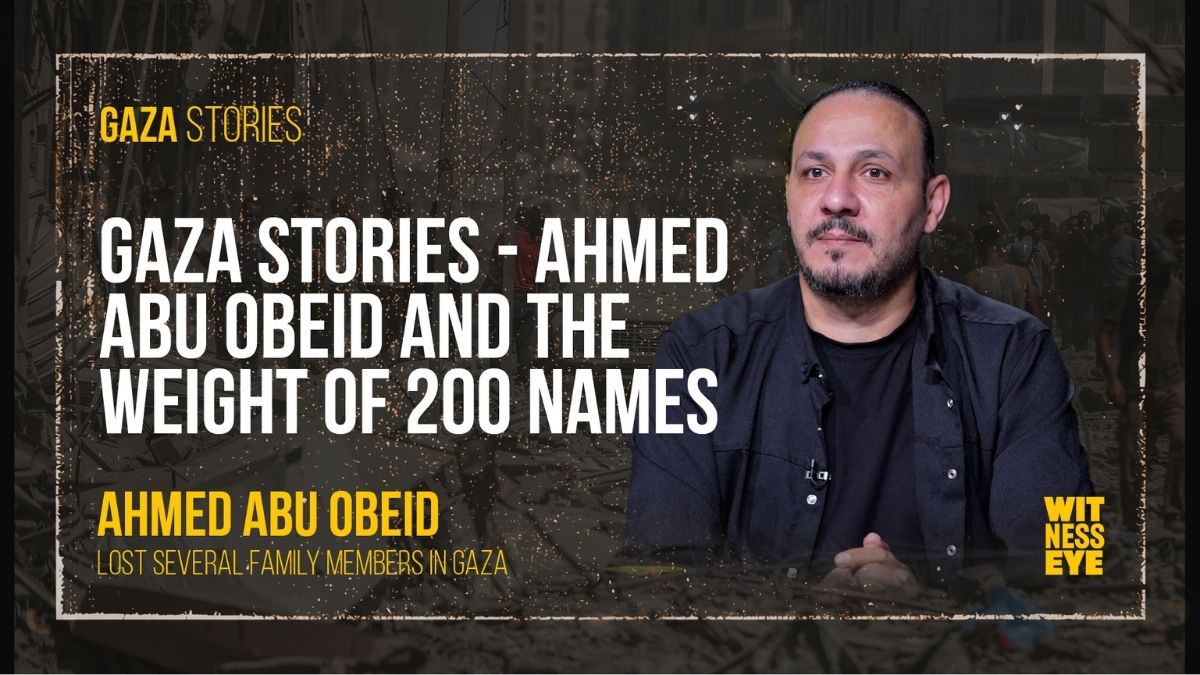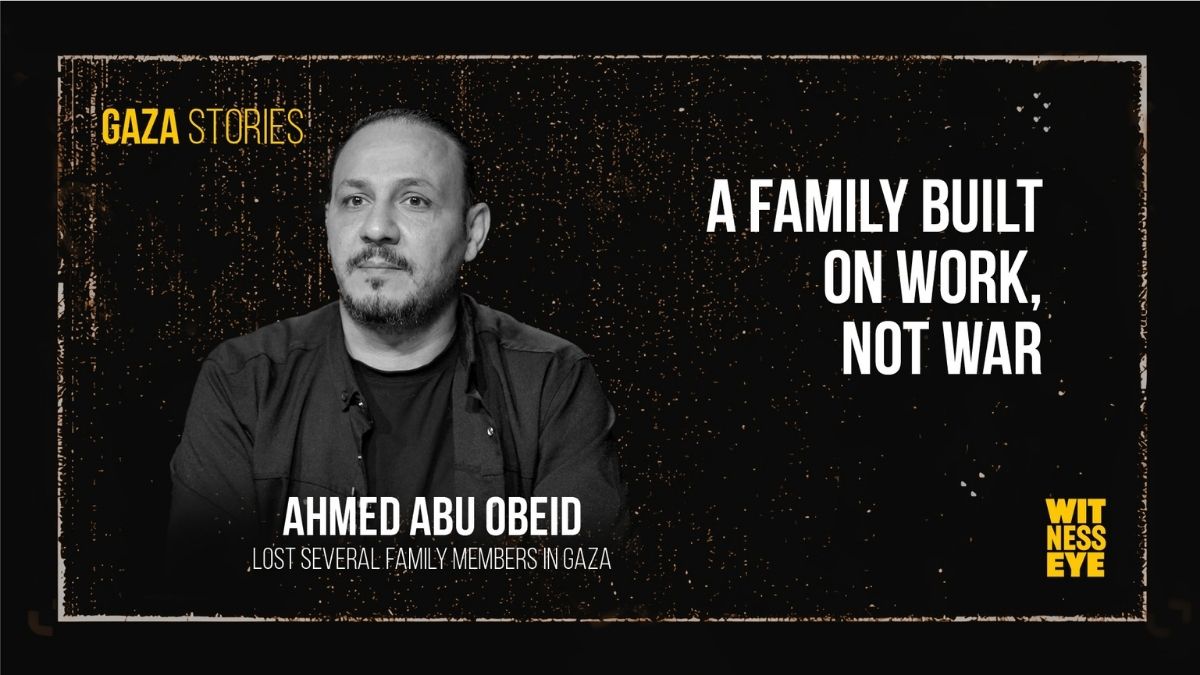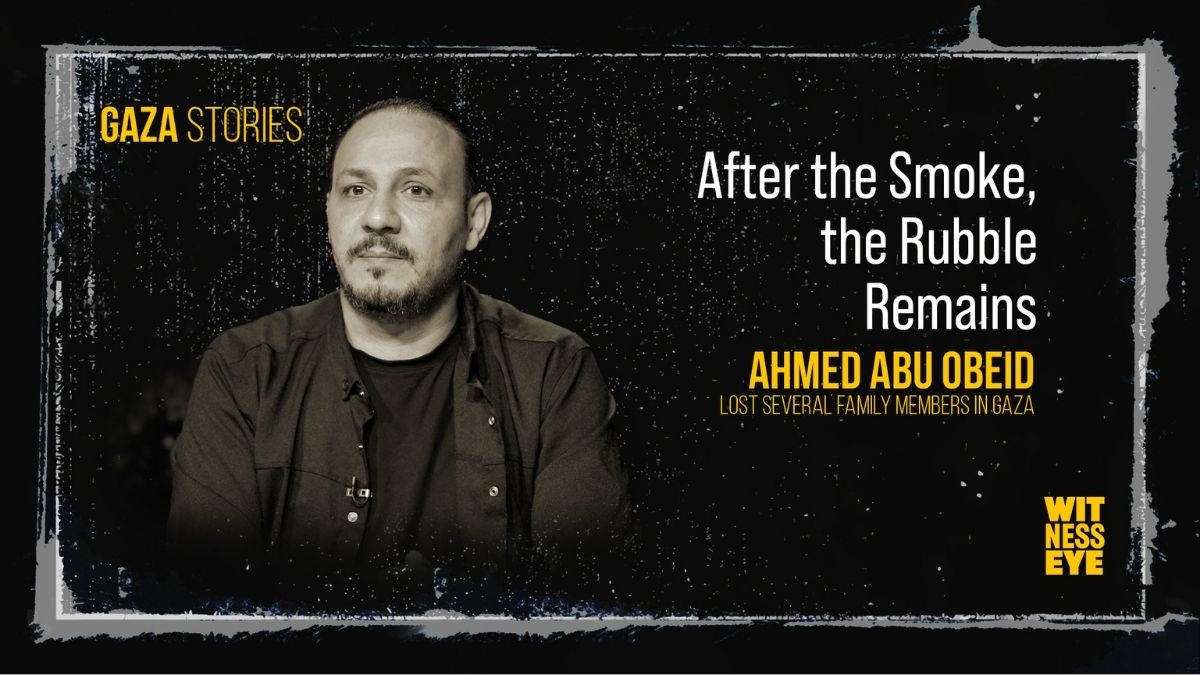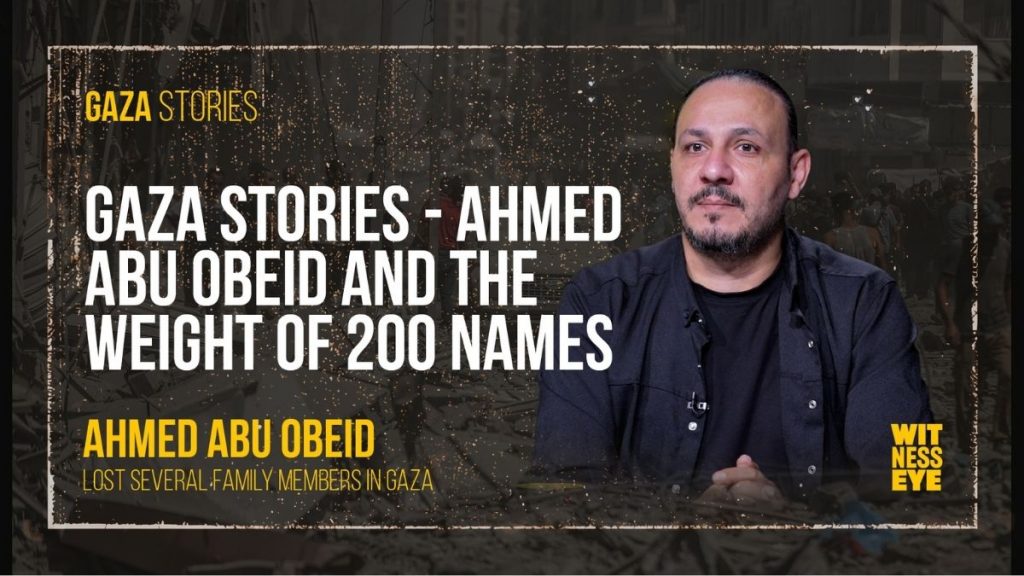
The first thing Ahmed tells me is where his family is rooted: the sand-colored lanes of Sheikh Radwan and the coastal strip everyone calls as-Sudaniyya. Before the war, that geography meant routine—factories humming, deliveries coming in, brothers arguing about prices and deadlines. “We’re a commercial and industrial family,” he says, not as a boast but as a baseline. Then the ground shifted. The phone became a siren. Telegram feeds turned into obituaries. One night a friend called from abroad: Open the channel. They’re live at your house. Ahmed watched his brothers lifted on stretchers, small bodies he could name by hair curls and pajamas. The screen didn’t blink. Neither did he. This is Gaza Stories at its rawest: not an abstraction, but a ledger of names you once kissed on the forehead.
“We counted more than 200 from our extended family,” Ahmed says. “From my father’s house alone—brothers, nieces, my sister and her children—over 30.”
In the distance, trucks stand like tired animals; in his memory, a single sentence repeats: What did we do? He isn’t asking for sympathy. He’s making a record.

A Family Built on Work, Not War
His father is nearly eighty. For decades the Abu Obeid and Nweiga names meant concrete, rebar, blocks, and payroll—imports, exports, tenders. “My father had the VIP permit. He could pass checkpoints, visit Jerusalem, go to the West Bank,” Ahmed says. That access came with a family rule: no politics, not even at the dinner table. “We were forbidden to express opinions. Our business depended on not getting detained, not having accounts frozen.”
They lived like many in Gaza: close to each other, doors that never quite close, cousins who wander in for tea and leave with a shopping list. “Grandfather, sons, and grandchildren—more than 1,200 people,” he says with a quiet pride. Then comes the line that sits like a stone: In this genocide war, a big family also means a big target.
If you’re following our archive of Gaza Stories, you know this pattern. Families who built the city are burying it now. You can browse the human spine behind the headlines in our Gaza Stories category and our reporting from the Gaza Tribunal.
“Then They Bombed Our House”
It was the first week. Evacuation orders blurred into rumors. One branch of the family went south to Deir al-Balah—a “safe zone.” “They were bombed there,” Ahmed says. “My brother’s wife and their five-year-old were martyred with her entire family.” The others stayed in Sheikh Radwan, sleeping in the warehouse. At 10 p.m., without warning, the house went down.
“I saw it live on TV,” he tells me. “My brothers carried on stretchers. My nephews—I recognized some; the rest were parts.” Sixteen from that building in a single strike, including the youngest—five months old. He doesn’t say the baby’s name. Some names live better in silence.
We’ve put similar strikes into context through our Civilian Impact Reports and War Crimes Documentationtags, where testimonies like Ahmed’s sit beside dates, maps, and legal framing under International Humanitarian Law.
Gaza Stories – Counting the Missing, Burying at Home
A siege wrapped itself around the neighborhood. Two young men—one with an Israeli work permit, another an excavator operator who rescued neighbors from rubble—stepped out to find food. “A drone hit them. Both were martyred,” Ahmed says. In the days that followed, the Arouk family house—where his sister lived—was hit: a three-story building, more than twenty gone. “My sister, her husband, their five children, and my brother’s daughter with her husband and two kids,” he says. Grief didn’t move in a line; it fell in layers.
When bodies couldn’t reach the cemetery, families turned courtyards into graves.
“My cousin, seventeen, was sniped on the roof while feeding pigeons. His grandmother and brother buried him in the yard,”
Ahmed says. Our ongoing Gaza’s Missing tracking and Civilian Casualty Mapping archive aim to keep every loss from dissolving into a statistic.
If you need a deeper backdrop to this aching ledger, read Gaza’s Missing: Thousands Lost in the Shadow of Warand Gaza Stories: Final Words Between Grief and Duty.
Hunger, Cold, and the Quiet Ways People Die
Some wars announce themselves with thunder. Others arrive through the body’s slow dimming—cold, hunger, infections that never meet a doctor.
“They used to say no one dies of hunger or cold in Palestine. Now we do,”
Ahmed says. An uncle with cancer, stable before the war, died shivering in a tent. Another uncle died of hunger, “weight under 30 kilos.” His father, once counted among Gaza’s successful businessmen, waited in line for water at an UNRWA school.
Money didn’t matter. Liquidity crashed; banknotes became museum pieces. “Even financially capable people can’t help. Fifty percent commission just to turn transfers into cash—if they can withdraw at all.” You can see these patterns reflected in our Civilian Impact Reports and documentation of Destruction of Civilian Infrastructure.
For a chorus of voices facing the same wall, revisit Gaza Justice: Voices of Justice and Grief from Gaza.
The Bulldozers They Feared
Ahmed’s family owns heavy machinery: excavators, trucks—lifelines when buildings collapse. “The army called my father directly—‘This is Captain Yusuf. Excavators must not move.’” Neighbors groaned beneath rubble; the machines were told to stay idle. “We didn’t listen. My nephew, nineteen, tried anyway. They bombed him once, twice, three times. He survived, almost lost his leg,” Ahmed says.
Footage exists, he tells me, of excavators standing still, then being hit. That isn’t combat; that’s method. If your work is to lift concrete, your crime becomes hope. We file sequences like these into Digital Evidence Archive and Forensic Investigations—breadcrumbs the world can verify.

Factories Turned to Dust
Before the temporary ceasefire, the family’s concrete and block plants were intact, raw materials stacked: a thousand tons of cement, enough to raise hundreds of small shelters. “My father said: as soon as guns go quiet, we run the lines and build two rooms next to the land,” Ahmed recalls. The next day, as troops withdrew, charges detonated. “They blew up the factories with the stock—deliberately—one day before the truce,” he says.
That blast wasn’t just about property. It was about breaking the will to stay. Our Military Conduct Analysis and Crimes Against Humanity dossiers follow these patterns across districts and months, alongside War Crimes Documentation and Genocide Evidence Files. For proceedings and public testimony, see Gaza Tribunal’s first public session in Bosnia and our Bosnia public session tag.
Ambushed by Hunger
The family’s warehouses, sometimes used by UN agencies to distribute aid, became traps. “People came saying they’d received a call: collect a coupon at Abu Obeid warehouse.” Seconds later, a drone strike. “They play on the string of hunger. They tell you ‘come eat,’ then bomb you,” Ahmed says. In other corners, a “humanitarian” brand drew crowds the same way—and killed hundreds.
We’ve catalogued these ops under Human Rights Violations—Gaza, Civilian Casualty Mapping, and Social Media Evidence to preserve call logs, SMS screenshots, and geotagged clips that courts can interrogate later.
For related first-hand accounts that braid grief with proof, spend time with Gaza Stories: A Mother’s Last Words, A Family’s Goodbye and Gaza Stories: Hossam’s Fight to Witness.
What Exile Can—and Can’t—Do
Ahmed speaks from abroad, but there’s no comfort in distance. “Maybe being with them would be easier than watching them hungry,” he says. He tries legal bank transfers. If the money reaches Gaza, turning it into cash empties half of it in fees—assuming an ATM still hums. “My father tells me: I have money. Can you get a kilo of meat? There isn’t any,” Ahmed says. When his brother was injured, “no blood came out—no nutrition left to circulate.”
This is where Gaza Stories must lean on International Justice and Legal Accountability Cases. Economic strangulation isn’t a side plot; it’s central harm, the quiet multiplier. To follow how jurists are parsing these harms, see Gaza legal review and Gaza Tribunal Reports.
“We Are Not Numbers”
If called to testify, what would he ask a court? “Why the double standards?” Ahmed’s voice doesn’t rise. It doesn’t need to. “Say every male is a suspect—by their logic. Fine. Then tell me about the eighty percent who are women and children.” He pauses. “Tell me about them.”
That request mirrors why Gaza Stories exists: to insist on the face behind each figure. Documentation isn’t a hobby; it’s survival. Browse Witness Eye and Besa Witness Eye tags to track how community testimony builds the scaffolding for Forensic Investigations and Digital Evidence Archive work—brick by careful brick.
For a sweeping look at the movement of testimony into venues of law, read Gaza Justice: Voices of Justice and Grief from Gaza and Gaza Stories: A Test for Humanity (Part 1) and (Part 2).

After the Smoke, the Rubble Remains
Even if the guns fall silent today, recovery isn’t a sunrise—it’s a quarry. “Months just to remove rubble, and that’s if new machinery gets in,” Ahmed says. The family’s equipment—those stubborn excavators, the trucks that doubled as ambulances—were hunted where they stood. “They filmed themselves blowing up idle machines,” he says. That’s a message, not a mistake: Leave. Don’t rebuild.
So where does that leave the living? With orphans who ask a question mothers can’t survive—Where’s daddy? With warehouses that hold both flour and graves, streets that remember what your screen cannot, Gaza Stories that repeat the names until the echo becomes a case file.

If you’re tracking accountability, our Accountability Watchlist and Gaza war crimes tags collect the cases moving through different forums; Gaza War and Gaza hold the broader arc. Our News feed will continue linking testimonies like Ahmed’s to filings, hearings, and expert witness Gaza analyses.
Gaza Stories – The Ask
“Deliver our voice,” Ahmed says. “Don’t make us numbers.” That isn’t a slogan; it’s a duty. Share their names. Save the clips. Submit the forms. Push the files into venues that still promise a hearing. Gaza Stories began as a window; it has to become an archive sturdy enough for judges to lean on.
If you need a place to start, reread Gaza Tribunal’s first public session in Bosnia, then dive into Gaza Tribunal evidence. Stitch this story to others—Gaza Stories: Journalist in Exile; Gaza Stories: A Mother’s Last Words—until a pattern stands where denial used to be.
“We’ll be liberated one day,” he adds at the end. Not a prediction—more like a vow.
Now, hear the testimony of Ahmed Abu Obeid in his own words—businessman, survivor, witness—carrying Gaza’s grief, memory, and unyielding call for justice into the record of history.
Published By Besa Witness Eye
Stay Connected with Witness Eye
Follow us on our official channels:
